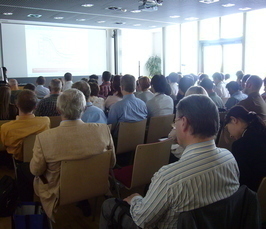MPI Kolloquiumsreihe: Dr. Janina Bahnemann, 3D-printed Microfluidic Systems for Cell Culture and Biological Applications
MPI Kolloquiumsreihe: Dr. Janina Bahnemann, 3D-printed Microfluidic Systems for Cell Culture and Biological Applications
- Datum: 23.01.2020
- Uhrzeit: 16:00 - 17:00
- Vortragende(r): Dr. Janina Bahnemann
- Leibniz Universität Hannover, Institut für Technische Chemie
- Ort: Max-Planck-Institut Magdeburg
- Raum: Großer Seminarraum "Prigogine"
- Kontakt: sek-bpe@mpi-magdeburg.mpg.de

Das Max-Planck-Institut Magdeburg lädt Sie herzlich zu seiner öffentlichen Kolloquiumsreihe ein. Hochrangige WissenschaftlerInnen verschiedener Fachgebiete aus renommierten Forschungseinrichtungen aus Deutschland und weltweit präsentieren ihre Forschungsarbeit.
Abstract
Microfluidics and the development of “lab-on-a-chip” (LOC) systems offer a great potential for a wide range of applications in medical engineering, biotechnology, biology and chemistry. Due to their capability to enable precise and rapid manipulation of cells and other biological samples, the interest in micro-structured systems has increased in recent years. In regard to biological applications, systems miniaturization can provide new strategies for testing the dynamic cell response to various external influences. In addition, LOC systems allow the establishment of continuous and reproducible experimental conditions and therefore they can maintain a native, physiologically favorable cell environment.
The small required sample volumes, low reagent consumption and the highly controlled and reproducible environment benefit various biological applications from nucleic acid and protein analysis to drug development and drug delivery. Additionally, numerous microfluidic systems for cell cultivation and cell manipulation have been reported, demonstrating capabilities, which would be far more complex to achieve, using traditional techniques. Despite the various applications demonstrated, the commercial use of microfluidics is still extremely limited. One reason for this lack of commercialization is the complex and time-consuming fabrication of the devices.
In recent years, three-dimensional (3D) printing has attracted growing scientific attention. Remarkable technical advancements allow for high-definition (HD) structures to be printed on a scale of only few micrometers. These developments can also be brought to bear in microsystems technology, and are increasingly exploited for 3D printing of microfluidic prototypes and single-use systems. Innovative HD 3D printing technology is increasingly used for the development of LOC prototypes for cell culture processes. A major advantage of 3D printed microsystems compared to traditional microfabrication methods is that desired prototypes can be printed within few hours. The 3D design and flow simulations of the LOC device can easily be performed using suitable software. Therefore, modifications needed in order to optimize the microfluidic system can be rapidly implemented and tested.